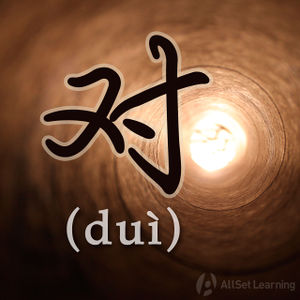Difference between revisions of "Using "dui" with verbs"
| Line 12: | Line 12: | ||
</div> | </div> | ||
| + | |||
| + | Note that you shouldn't be plugging in just any old verb here. Certain verbs are often used with 对, and some even '''''need''''' 对 if you want to add an object (like 感兴趣, explained below). | ||
== Examples == | == Examples == | ||
Revision as of 11:52, 2 June 2013
-
Level
-
Similar to
-
Used for
-
Keywords
When using 对 (duì) as a preposition, it is used to indicate "to" or "towards" a object or target. As with all prepositions, some care should be taken when using this particle, as usage of 对 doesn't always totally "make sense" or correspond to English at all.
Contents
Basic Structure
The structure is basically:
对 + Object + Verb Phrase
Note that you shouldn't be plugging in just any old verb here. Certain verbs are often used with 对, and some even need 对 if you want to add an object (like 感兴趣, explained below).
Examples
Here are some examples:
- 他 对 我 笑。
- 我 要 对 你 负责。
- 她 对 我 很 客气。
- 你 为什么 对 我 有 意见 ?
- 我 对 西安 不 熟悉。
- 抽烟 对 健康 有害。
对 is also used in two set structures: 对……来说 ("for... [a person]") and 对...感兴趣 ("to be interested in...").
对……来说
This essentially means "for... (a person)." It's for making a statement from a certain person's point of view.
The pattern is:
对 + Person + 来说
- 川菜 对 我 来说 太 辣 了。
- 对 她 来说 英语 很 容易。
- 对 我 来说 书法 很 有意思。
对……感兴趣
In English was say "to be interested in something." In Chinese, the pattern is:
对 + Object + 感兴趣
- 我 对 书法 感 兴趣。
- 谁 对 英语 很 感兴趣?
- 你 好像 对 她 不太 感兴趣。
See also



